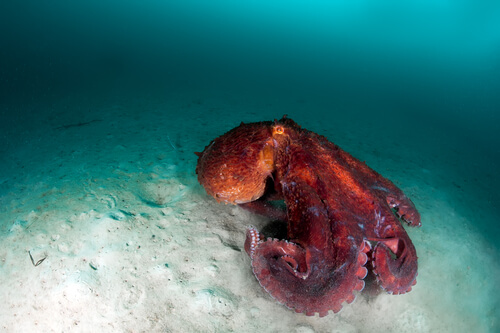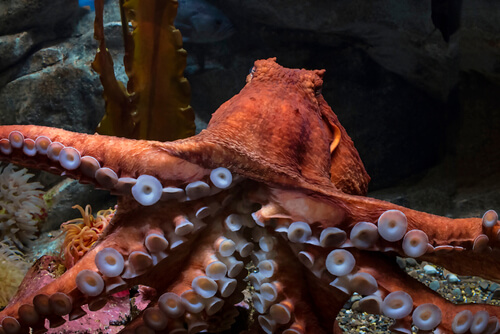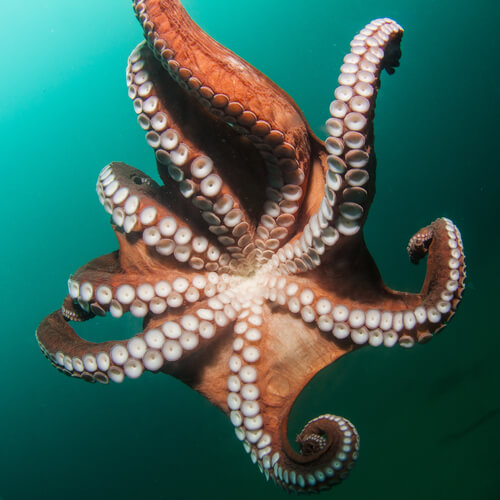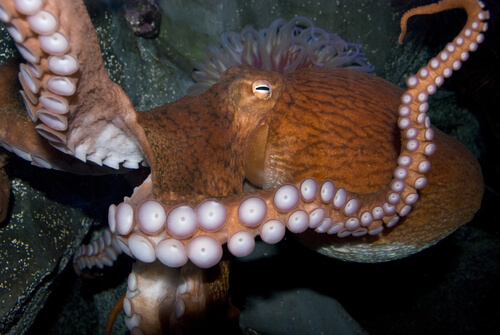
| Kingdom | Animalia |
| Phylum | Mollusca |
| Class | Cephalopoda |
| Order | Octopoda |
| Family | Enteroctopodidae |
| Genus | Enteroctopus |
| Species | E. dofleini (formerly Octopus apollyon) |
| Niche | Venomous octopus |
| Length | 16 ft (5 m) |
| Weight | 110 lb (50 kg) |
| Lifespan | 4-5 years |
| Social Structure | Solitary |
| Conservation Status | Not threatened |
| Preferred Habitat | Coastal waters to 330 ft (100 m) |
| Average Clutch Size | 74,000 eggs |
| Main Prey Species | Crustaceans, fish |
| Predators | Humans, birds, eels, fish, sharks |
The Basics
The giant Pacific octopus is a cephalopod species native to the northern Pacific Ocean. It is the largest octopus species in the world, the largest specimen ever having weighed 600 pounds and more than 30 feet across!
Description
The giant Pacific octopus, like all species of octopus, have eight arms on top of which sit a bulbous ‘mantle’. Most individuals are usually a deep red or pinkish color. The giant Pacific octopus is the largest octopus species in the world, normally growing to about 16 feet in length and weighing more than 100 pounds. Females tend to be larger than males, and like all octopus species, their overall size depends significantly on temperature and the availability of nutrients and light in their particular habitats.

Like all other cephalopods, the giant Pacific octopus uses a jet-propulsion technique of expelling water from a funnel-shaped part of its respiratory system.
Habitat and Distribution
The giant Pacific octopus tends to inhabit rocky coastal areas to depths of up to 300 feet. It is best adapted to cold, nutrient-rich environments and their distribution ranges throughout the northern Pacific Ocean from Japan to Alaska and the west coast of North America as far south as Baja California, Mexico. They can often be found in tide pools within the intertidal zone or hiding in crevices along the substrate. Outside of their lairs, they will often pile rocks and other items, securing themselves in their own natural safe room out of the reach of predators.
Predators and Prey
The giant Pacific octopus is largely nocturnal, hunting at night for crustaceans such as shrimp and crabs as well as various species of fish. It has also been known to eat small sharks, using their beak-like mouths to fatally wound their prey before consuming it.
Since they lack a protective outer shell present in most other mollusks, octopuses like the giant Pacific octopus are dependent on both ability to camouflage themselves and to hide in small crevices in their rocky habitat. They will do this to avoid various shark and fish species that hunt octopus, often during the night to avoid detection themselves. Depending on the size of the individual octopus, birds, eels, and other animals such as seals and otters are also a threat to the giant Pacific octopus.
When the giant Pacific octopus is unable to hide in its den or effectively camouflage itself, it can also rely on its speed and evasive behaviors. Their jet propulsion system allows them to quickly accelerate while the production of a toxic black ink which they can spray their predators with allows them yet another way to avoid being captured.
Reproduction
The giant Pacific octopus normally lives for about five years, making them one of the longest-living species of octopus. Females reach maturity at about 2-3 years of age. At this time, males may approach females and effectively caress her with one of its arms. If well-received, the male will grab on to the female with its other arms, and insert its sperm packets into her mantle cavity using his hectocotylus, a modified arm.
Females lay about 74,000 eggs in a clutch, normally in a deep den or cave. Here, she will spend all of the next seven months watching over them and ensuring that they are receiving enough oxygen. During this time, the female octopus does not eat, subsisting on her own body fats and other tissues.

Once the eggs hatch, the female dies, and her offspring will be completely independent. They begin as tiny octopuses floating in the plankton until they reach about 50 mm in length, at which point they will descend from the water column and take up a largely benthic existence for the rest of their lives. The giant Pacific octopus is a semelparous species, breeding only once in their lives.
Conservation Status
Completing population surveys of the giant Pacific octopus is difficult mostly as a result of its elusive behavior, often hiding in cracks and crevices or camouflaging itself to avoid detection. Although there still exists a commercial fishery in North America and Japan for the species, populations remain resilient.
Fun Facts about the Giant Pacific Octopus!
For such a shy and elusive animal, the giant Pacific octopus has long fascinated scientists and beach-goers alike.
Full of Hearts
Octopuses and other cephalopods have unique circulatory systems highlighted by the presence of three separate hearts to help circulate blood throughout its body. Two of these hearts – the branchial hearts – pump blood to the gills where it can become re-oxygenated much like occurs in the lungs of mammals such as humans. The third heart, known as the systemic heart, moves blood to the rest of the body, including its eight tentacles.
Octopuses are known for having blue blood, a somewhat unique feature. Whereas humans and many other animals have iron-rich blood on which we rely to transport oxygen throughout our bodies, cephalopods have copper-rich blood that serves the analogous purpose of oxygen transport. This copper-based molecule is known as hemocyanin and causes their blood to appear blue rather than the red color caused by hemoglobin-based blood.
Chromatophores
The giant Pacific octopus and other cephalopods are masters of camouflage, often being able to change the color and texture of their skin to mimic common items in their environment such as rock substrates and macroalgae (seaweed). These abilities are made possible due to the presence of special pigment cells called chromatophores that sit just below the surface of the skin. These unique pigment-filled cells cover almost their entire bodies and allow them to change colors within one-tenth of a second.

Within each chromatophore is an elastic, pigment-filled sac. These are controlled by various muscles and the octopus’ unique, widely-distribute nervous system. When these muscles contract, the sac expands, revealing more vibrant pigments such as yellows and reds. When the octopus relaxes these muscles, the sac returns to its normal size and the pigments become less visible. In combination with the species’ ability to change the texture of its skin, these chromatophores can be used to carefully mimic complex surfaces such as a rocky substrate covered in various species of colorful algae and other benthic species.
Nine Minds
The nervous system of cephalopods is very unique and includes the presence of nine ‘brains’. They have one central brain that is used to control their nervous system while mobility is largely controlled by the other eight brains – one located in each of their eight tentacles. Up to two-thirds of the octopus’ nervous system is located in its arms which allows them to use their complex array of about 2,200 ‘suction cups’ to effectively smell and taste with their arms. This also provides a high level of mobility and tactility, allowing the octopus a powerful grip and as well.
‘The Brain’
Although their nervous system is unique and non-analogous to mammalian nervous systems, the giant Pacific octopus is a very intelligent animal that can learn to complete various novel tasks such as open jars and play with toys. In addition, they can learn to recognize other individuals, including their handlers in the case of specimens kept in captivity at aquariums. It is not surprising, therefore, that the giant Pacific octopus – the largest of all octopus species – continues to fascinate
